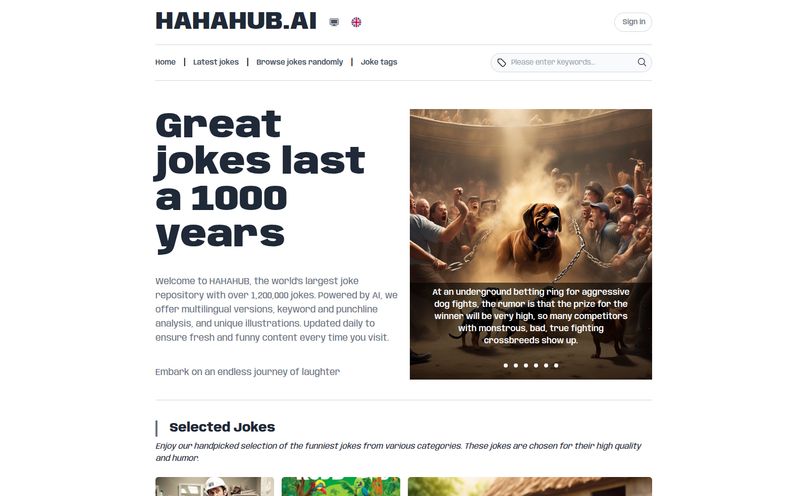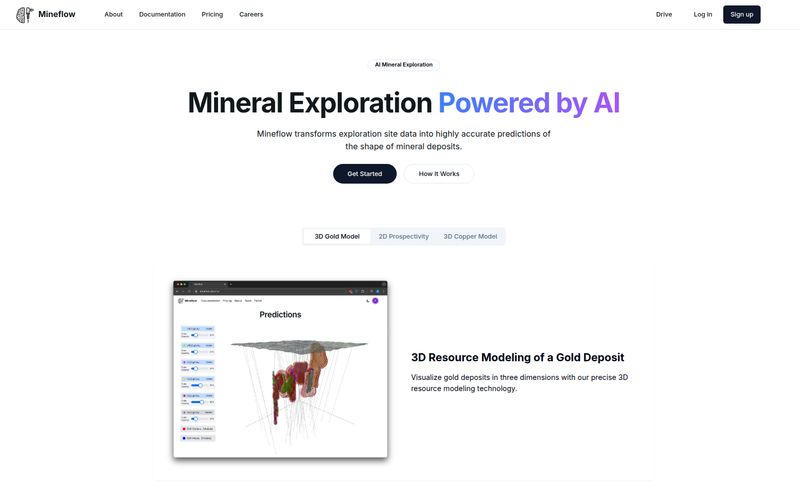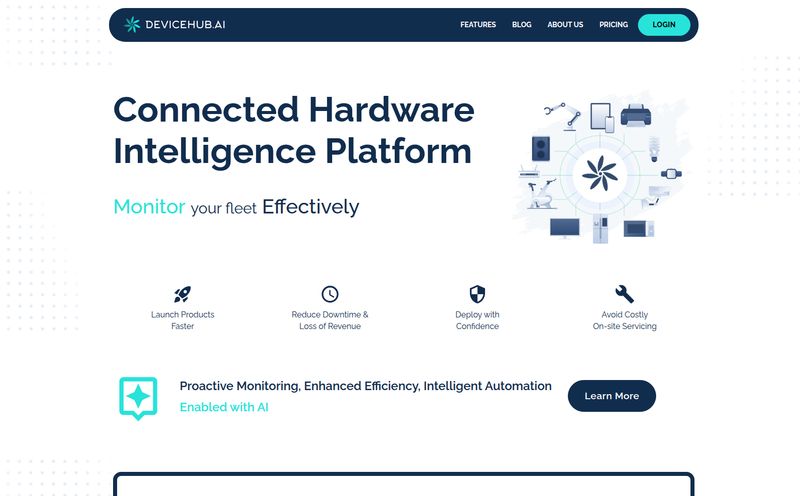As someone who spends a frankly embarrassing amount of time digging through data, trends, and academic papers for SEO insights, I have a real soft spot for clever research tools. We've all been there, right? You're deep in a research rabbit hole, chasing down a thread, but you keep hitting a wall. You're using keywords like "user engagement metrics" but the foundational paper you really need calls it "visitor interaction heuristics" or something equally arcane. You're missing entire forests for the trees.
It’s the classic keyword trap. You only find what you know to look for.
A while back, a tool called Citrus Search popped onto my radar. It promised a different way. A smarter way. Instead of just matching words, it matched ideas. It was a fantastic concept. I went to check on it recently, to see how it was getting on, and was met with... well, a 404 error. A ghost in the machine. So, let’s pour one out for a lost tool and talk about what made the idea behind Citrus Search so brilliant.
Beyond the Keyword Abyss
Standard search is great if you know exactly what you’re looking for. But true research, the kind that leads to breakthroughs or just a really killer content strategy, is about discovery. It’s about finding the connections you didn’t even know existed. Relying solely on keyword search for this is like trying to understand a family tree by only looking up one last name. You miss all the marriages, the cousins, the weird uncle everyone pretends not to know.
This is a huge problem in scientific literature. Different fields develop their own terminology, their own taxonomy. A concept in computer science might be incredibly relevant to a sociologist, but they'd never find each other's work because they don't speak the same academic language. This is the wall Citrus Search was trying to tear down.
The Big Idea Behind Citrus Search
So what was this thing supposed to be? At its core, Citrus Search was a similarity-based search engine. The process was simple and elegant. Instead of a keyword, you started with a seed paper. You’d find one paper that was highly relevant to your topic—your ground zero—and plug it into Citrus.
From there, the platform’s machine learning engine would crawl through its massive database (powered by the Semantic Scholar Open Research Corpus, with over 200 million publications) and find papers that were conceptually similar. It was less about matching words and more about understanding context. It did this in two clever ways:
- Citation Network Analysis: This is like digital archaeology. It looked at which papers were cited by your seed paper, and which papers cited your seed paper in the future. It maps the intellectual lineage, showing you the ancestors and descendants of an idea.
- Content-Based Similarity: This mode looked at the actual text, the abstract, and the body of the work. It used natural language processing to understand the core topics and arguments, finding other papers that talked about the same stuff, even if they used different words.
You could toggle between these modes, depending on whether you were more interested in the conversation around a paper or the content within it. A seriously cool feature.

Visit Citrus
The Timeline View was a Game Changer
Okay, this was the feature that really got me excited. Citrus didn't just give you a list of papers. It plotted the most important contributions on a visual timeline. What a concept. You could instantly see the seminal paper from 1998 that started it all, the major developments in the 2000s, and the current state-of-the-art papers published last year.
Anyone who has ever had to manually construct a literature review knows the pain of this process. It takes hours, days even, of painstakingly cross-referencing dates and citations. Citrus promised to do it with one click. It was a map of an entire research field’s history, laid out right in front of you. That’s not just a time-saver; it’s a tool for deeper understanding.
The Promise and the Inevitable Pitfalls
No tool is perfect, of course. And since Citrus Search was flagged as being "under active development," it came with a few quirks. The reliance on a seed paper meant you had to have a good starting point. If your initial paper wasn't quite right, you could get sent down the wrong path entirely. It had a bit of a cold-start problem.
And, naturally, being a work in progress meant there were probably bugs. We’ve all been early adopters of a promising beta that just wasn’t quite ready for prime time. But the promise was so immense: a way to break out of information silos, discover new connections, and grasp the historical context of an idea in minutes. That's a powerful trifecta.
So, Where Did It Go?
Which brings us back to that sad little "404 Not Found" page. What happened? In the fast-moving world of tech tools and startups, this story is all too common. Projects like this are often born from academic research or a developer's passion. Sometimes they just run out of funding or manpower. The lead developer gets a new job, the server costs get too high, or a bigger fish comes along and makes a better version. It's a tough ecosystem.
Seeing that 404 reminded me that innovation is often fragile. For every massive platform like Semantic Scholar that thrives, there are a dozen brilliant-but-small projects like Citrus Search that flicker and fade. It's a shame, but it also highlights just how hard it is to build and maintain these valuable resources.
Great Alternatives for the Curious Researcher
The good news? The spirit of Citrus Search lives on! If you were intrigued by this idea of similarity-based research, there are a few other fantastic tools out there that have picked up the torch. If you're looking to fill that gap, I’d strongly suggest you check these out:
- Connected Papers: This is probably the closest direct alternative. You plug in a paper and it generates a beautiful, interactive graph of similar articles. It’s fantastic for visualizing a research field.
- ResearchRabbit: Another amazing tool that bills itself as a "Spotify for papers." You can build collections of papers, and it will recommend new and relevant articles, letting you fall down the best kind of rabbit hole.
- Semantic Scholar: The very source of Citrus’s data has powerful built-in similarity features. Every paper on its platform has a "Related Papers" tab that is surprisingly effective.
So while we may have lost one tool, the underlying idea is stronger than ever. The move away from rigid, keyword-based searching and toward a more intuitive, context-aware discovery is the future. And honestly, it cant come soon enough.
Final Thoughts on a Great Idea
I might be romanticizing a tool that I never got to use in its prime, but I dont think so. The concept behind Citrus Search was, and is, rock solid. It addressed a genuine pain point for anyone who does deep research. It’s a reminder that the best tools aren’t just about raw power, but about changing your perspective.
Even though the site is gone, the idea is a good one to keep in mind. Next time you feel stuck in a research rut, dont just try different keywords. Try a different approach. Find a seed paper and explore its connections. Think in terms of timelines and conversations, not just search queries. The ghost of Citrus Search would be proud.
Frequently Asked Questions
What was Citrus Search?
Citrus Search was a similarity-based search engine designed for scientific and academic literature. Instead of using keywords, you would input a "seed paper," and the tool would use machine learning to find other conceptually similar articles based on citation networks and content analysis.
Is Citrus Search still available?
Unfortunately, it appears Citrus Search is no longer active. The website currently returns a "404 Not Found" error, suggesting the project has been discontinued.
What are some good alternatives to Citrus Search?
Yes! If you're looking for tools with a similar function, you should check out Connected Papers, ResearchRabbit, and the built-in recommendation features of Semantic Scholar. They all help you discover related research based on a starting paper.
Why is similarity search useful for research?
Similarity search helps overcome the limitations of keywords. It can uncover relevant papers that use different terminology or are from different academic fields, helping you see the bigger picture and discover connections you might have otherwise missed.
Was Citrus Search a free tool?
While the project was active, it appeared to be free to use. It was positioned as a tool under development, and there was no pricing information available, which is common for academic or beta-phase projects.
How did Citrus Search find similar papers?
It used a combination of two machine-learning techniques. The first analyzed the citation network (who cited the paper and who it cited). The second analyzed the paper's actual content (its text and abstract) to find other papers discussing similar topics.



